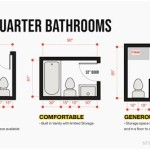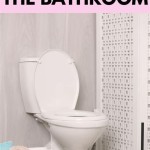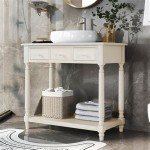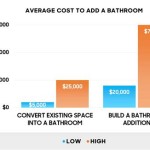Wall Mirrors for Bathroom Vanities: A Comprehensive Guide
The bathroom vanity mirror serves a purpose far beyond simple reflection. It is a pivotal element in bathroom design, impacting both functionality and aesthetics. Selecting the appropriate wall mirror for a bathroom vanity requires careful consideration of size, shape, style, lighting, and installation factors. An informed decision ensures a practical and visually appealing space.
Understanding Mirror Size and Placement
Determining the correct size of a bathroom vanity mirror is crucial for achieving proper proportion and usability. A mirror that is too small can appear insignificant and fail to provide adequate reflection, while one that is excessively large can overwhelm the vanity area. A general guideline suggests the mirror should be a few inches narrower than the vanity itself. This creates a balanced and harmonious visual effect.
The height of the mirror also matters. Ideally, the bottom edge of the mirror should be positioned approximately 5 to 10 inches above the backsplash. This provides comfortable viewing for individuals of varying heights. If multiple users will be sharing the vanity, consider positioning the mirror at an average height that accommodates everyone comfortably.
Placement should account for other bathroom fixtures and architectural elements. Consider the presence of light fixtures, medicine cabinets, and wall-mounted storage. The mirror should not obstruct access to these elements and should complement their design. In smaller bathrooms, strategically placed mirrors can create the illusion of increased space.
For double vanities, there are typically two approaches: a single large mirror spanning the entire length of the vanity or two separate mirrors, one above each sink. The choice depends on the available space, design preferences, and the desired level of individualization. A single mirror promotes a sense of continuity and spaciousness, while separate mirrors offer more personal space and definition.
Exploring Mirror Shapes and Styles
The shape of the bathroom vanity mirror significantly influences the overall aesthetic of the bathroom. Common shapes include rectangular, square, round, oval, and arched. Each shape imparts a distinct character to the space.
Rectangular mirrors are a popular choice for their versatility and clean lines. They complement a wide range of vanity styles, from traditional to contemporary. Square mirrors provide a symmetrical and balanced look, often used in modern or minimalist bathroom designs.
Round and oval mirrors introduce a softer, more organic element into the bathroom. They can be particularly effective in softening the sharp angles of a more angular bathroom design. Arched mirrors add a touch of elegance and sophistication, creating a focal point in the vanity area.
Beyond the basic shapes, mirrors are available in a variety of styles, from frameless to ornate. Frameless mirrors offer a sleek, minimalist aesthetic, blending seamlessly with any décor. Framed mirrors, on the other hand, provide an opportunity to introduce texture, color, and detail to the bathroom.
The frame material can range from wood and metal to resin and glass. Wooden frames add warmth and natural beauty, while metal frames offer a more contemporary and industrial look. Resin frames are durable and moisture-resistant, making them ideal for bathroom environments. Glass frames add a touch of glamour and sophistication.
The style of the mirror should complement the overall design of the bathroom. A traditional bathroom might benefit from a mirror with an ornate frame and classic detailing, while a modern bathroom might call for a frameless mirror with clean lines and a minimalist design. Matching the mirror style to the vanity style is crucial for creating a cohesive and harmonious look.
Analyzing Lighting Integration and Functionality
Proper lighting is essential for a functional and aesthetically pleasing bathroom vanity area. Insufficient lighting can make tasks such as applying makeup or shaving difficult, while harsh lighting can create unflattering shadows. Integrating lighting with the bathroom vanity mirror is an effective way to address these challenges.
Mirrors with integrated lighting offer a convenient and streamlined solution. These mirrors typically feature LED lights built directly into the mirror, providing even and balanced illumination. LED lights are energy-efficient, long-lasting, and produce a natural-looking light that is ideal for grooming tasks.
There are several types of integrated lighting options available. Backlit mirrors feature lights behind the mirror, creating a soft, ambient glow. Front-lit mirrors feature lights around the perimeter of the mirror, providing direct illumination of the face. Sidelit mirrors feature lights on either side of the mirror, offering balanced and shadow-free lighting.
When selecting a mirror with integrated lighting, consider the color temperature of the light. Warmer light, with a color temperature of around 2700K to 3000K, creates a cozy and inviting atmosphere. Cooler light, with a color temperature of around 4000K to 5000K, provides brighter, more daylight-like illumination that is ideal for tasks requiring precision.
In addition to integrated lighting, consider adding supplementary lighting fixtures around the vanity area. Sconces mounted on either side of the mirror provide balanced and flattering lighting. Overhead lighting, such as recessed lights or a pendant light, can provide ambient illumination for the entire bathroom.
The placement of lighting fixtures is crucial for achieving optimal illumination. Sconces should be positioned at eye level to minimize shadows. Overhead lighting should be positioned to avoid casting shadows on the face while using the mirror.
Dimmable lighting controls allow for adjusting the brightness of the lights to suit different tasks and moods. This provides flexibility and control over the lighting environment.
Considering Installation and Mounting Options
Proper installation is essential for ensuring the safety and longevity of the bathroom vanity mirror. Incorrect installation can lead to damage to the mirror, the wall, or even personal injury. Several installation options are available, each with its own advantages and disadvantages.
Direct mounting is the most common installation method. This involves attaching the mirror directly to the wall using screws and anchors. This method is relatively simple and straightforward, but it requires careful planning and execution to ensure the mirror is securely mounted.
When direct mounting, it is important to locate the wall studs and anchor the screws into the studs whenever possible. This provides maximum support and prevents the mirror from pulling away from the wall. If studs are not available, use appropriate wall anchors that are designed to support the weight of the mirror.
Hanging systems offer an alternative to direct mounting. These systems typically involve attaching a bracket to the wall and then hanging the mirror onto the bracket. This method allows for easier adjustment and removal of the mirror.
Tilt mirrors offer flexibility in adjusting the viewing angle. These mirrors are mounted on a pivoting mechanism that allows the user to tilt the mirror up or down to achieve the desired viewing angle.
Before installing the mirror, carefully measure the distance between the mounting holes and mark the locations on the wall. Use a level to ensure the mirror is mounted straight. Follow the manufacturer's instructions carefully when installing the mirror.
If unsure about the installation process, it is best to hire a professional to install the mirror. This will ensure the mirror is installed safely and correctly.
Choosing the right wall mirror for a bathroom vanity involves a careful consideration of several factors, including size, shape, style, lighting, and installation. By carefully evaluating these factors, one can select a mirror that enhances both the functionality and aesthetics of the bathroom, creating a space that is both practical and visually appealing.

Large Modern Wall Floating Mirror Bathroom Vanity Decorative

Klajowp 36 In W X 24 H Small Rectangular Framed Wall Mounted Bathroom Vanity Mirror Black Rm01 6090 120 The Home

Tetote 60 X 30 Inch Silver Vanity Mirror Brushed Nickel Rectangle Metal Framed Modern Mirrors For Bathroom Farmhouse Round Corner Wall Mounted Horizontal Vertical Com

Andrea 84 In W X 36 H Large Rectangular Metal Framed Dimmable Antifog Wall Mount Led Light Bathroom Vanity Mirror Gold Xsm984 Bg The Home

Tetote 60 X 30 Inch Brushed Gold Bathroom Wall Mirror Metal Frame Vanity Rectangle Modern Decorative Mount Mirrors Horizontal Vertical Com

Large Modern Wall Floating Mirror Bathroom Vanity Decorative

27 Bathroom Mirror Ideas For Every Style Wall Decor

Dt Glass Custom Cut Bathroom Vanity Mirrors

10 Ideas For Double Vanity Bathroom Mirrors That Are A Ok Hunker Round Mirror Designs

Anyhi Bathroom Mirrors With Lights Led Vanities Long Anti Fog For Rectangle Large Silver Wall 48 X 24 Com
See Also







